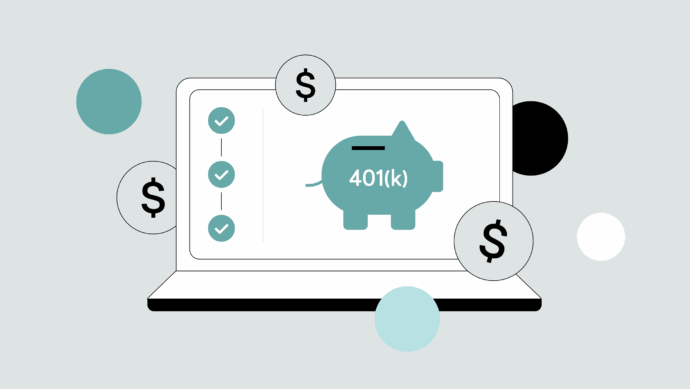
A Sermo study of over 500 physicians expressed that only 22% feel financially prepared to retire.
As one Sermo member expressed, “Most physicians go through life without ever formally learning about financial planning, managing a budget or basic principles of spending vs. investment vs. savings.”
As a result, many struggle financially—even though they earn high incomes. Learning about 401ks for doctors and how to manage them is a meaningful step toward financial peace.
This article is for educational purposes only. Consult a licensed financial professional for personalized advice.
Table of contents
What is a 401k and should you get one?
401ks are employer-sponsored retirement vehicles. You choose to contribute a portion of your paycheck to the account, and the employer sometimes matches it. Typically, you choose from a predetermined menu of investments—mutual funds, exchange-traded funds (ETFs) and occasionally company stock.
The Department of Labor (DOL) and Internal Revenue Service (IRS) regulate 401k plans. The IRS oversees tax-related components, including annual contribution limits and eligibility rules for tax benefits.
There are two primary 401k plans: Roth and Traditional. The key difference between the two is how the IRS taxes them:
- Roth 401k: Investors fund their Roth 401k with after-tax contributions and benefit from tax-free withdrawals in retirement.
- Traditional 401k: Investors fund their Traditional 401k with pre-tax dollars. This lowers their current taxable income and defers taxes until retirement.
If you’re in private practice, you may be eligible for a Solo 401k—occasionally called an individual or private 401k. Solo 401k plans are for private practice owners with no employees (other than spouses). Like traditional 401ks, they’re tax-deferred, but offer broader investment options and higher contribution limits.
Many physicians also ask, “How can you invest for retirement if your employer doesn’t offer a 401k plan?” Individual retirement arrangements (IRAs) are another form of retirement savings plan. Like 401ks, make sure you understand the different types of IRAs, how they’re taxed, contribution limits and other key factors before investing.
Pros and cons of 401ks for physicians
A Sermo poll reveals that only 56% of physicians contribute to their 401k regularly, while 23% don’t have one at all.
While it’s a good idea to invest in your 401k, consider the potential advantages and risks when making your decision.
401k pros
Advantages include tax favorability, employer matching and automated deductions:
Tax-advantaged
Traditional and Solo 401ks let you invest with pre-tax dollars, which lowers your current taxable income. When you withdraw funds in retirement, you pay taxes at your income tax rate at that time. Conversely, Roth 401ks require you to contribute after-tax dollars, so they don’t reduce your current taxable income, but you can withdraw funds tax-free in retirement.
Employer matching
Do doctors get a 401k match? Yes—most healthcare institutions offer employer matching for both Traditional and Roth 401ks. With this benefit, your employer matches your contributions up to a specified limit. The average employer match is 4.6%, which can really add up over time.
Simplified investing
401ks allow you to automate contributions—a simple discipline with significant impact. In a study of over 10,000 U.S. millionaires, 75% credited their success to regular, consistent investing over time. Automated payroll deductions make consistency easier.
Asset protection
The Employee Retirement Income Security Act of 1974 (ERISA) protects assets in your 401k from creditors. This means creditors can’t seize your 401k assets to satisfy malpractice judgments.
As one physician on Sermo explains, “401ks are qualified retirement plans that are 100% protected from creditors (i.e., med mal plaintiff lawyers, and anyone else that might want to sue you). IRAs do not offer the same level of protection from creditors. Asset protection always needs to be a number-one priority.”
401k cons
401ks do have their cons, which include the following:
Limited options
401ks have fewer investment choices than individual retirement arrangements (IRAs). Employers typically filter different retirement accounts offered by the 401k plan provider based on fees, risk diversification, historical returns and fiduciary compliance. Employers then present these vetted options to employees as the 401k investment menu. Most 401ks primarily offer mutual funds, but they can also offer index funds, ETFs, annuities, bonds and other assets.
While limited, 401ks typically offer high-quality, historically sound assets—sufficient for long-term wealth building. But not all physicians agree. One says, “I’m relying on other investments rather than a 401k. I’m in private practice as a practitioner. I feel like I can get a higher ROI than a typical 401k.” A pathologist adds, “As physicians, we could afford to take more risks and go all in with stocks.”
Fees
Most 401k plans have a few fees. There are three primary fee categories:
- Administration fees: These fees cover the plan’s day-to-day operations, like recordkeeping, accounting and other administrative costs.
- Investment fees: Typically the largest portion of 401k expenses, these fees pay for managing the plan’s investments—fund management fees, sales loads and certain asset-based fees. The plan provider often deducts them directly from investment returns.
- Individual service fees: These fees apply when participants use specific plan features, like taking out a loan or requesting specialized investment advice. Only those who use the feature pay the associated fee.
When you don’t plan to pay fees, they can lower your returns more than you might think. 401k plan providers must disclose all plan fees and related expenses to participants in a clear, comparative format so you know what you’re paying. If you have additional questions unanswered by the provider’s disclosure, speak to your plan’s administrator.
Early withdrawal penalties
Those 59½ or older can withdraw from a 401k without incurring early distribution penalties. Those younger than 59½ generally owe a 10% early-distribution penalty. However, the IRS allows various exceptions that waive this 10% fee, which includes people who need funds for medical expenses exceeding 7.5% of their adjusted gross income. Even if you qualify for an exception, you typically still pay regular income tax on the distribution.
Contribution limit
The IRS sets annual 401k contribution limits. In 2025, it’s $23,500 for individual contributions or $70,000 for combined employee-employer contributions. This applies to all 401k plans. Those aged 50 and above can make additional annual catch-up payments of $7,500. By contrast, IRAs have a contribution limit of $7,000, or $8,000 if you’re age 50 or over.
This limit means that many physicians have to invest elsewhere to make the most of their money. As one U.S.-based GP adds, “401k is a good safe long-term option, but also important to diversify and have shorter-term savings as well.”

How can you maximize your 401k savings as a doctor
When asked if they felt their 401k investments were sufficient for retirement, 28% of physicians said yes, 34% said maybe, and 22% said no. While many feel confident about their retirement plans, a solid number might wonder if there are more ways to make the most of their money.
Here’s how to optimize your 401k plan:
Contribute 15% to your 401k
To fund your retirement lifestyle, aim to build a nest egg that allows you to withdraw 4–6% each year without depleting your principal. High-earning physicians can feasibly reduce this to 2–3%, though it depends on the situation.
Analysts recommend these withdrawal rates because historically, U.S. investment vehicles have averaged annual returns exceeding 6%. Consistently contributing 15% of your income to a 401k throughout your career can grow a nest egg large enough to sustain a comfortable 4% withdrawal rate in retirement.
Here’s an example. The average U.S. family medicine physician’s salary is about $252,217. A family medicine doctor who invests 15% annually through their traditional 401k into a broad-based U.S. equity fund over 35 years will retire with approximately $10.25 million. That equates to a 4% withdrawal rate of $410,000, before fees and taxes.
According to one Sermo poll, 30% of surveyed physicians contribute 5–10% of their salaries to a 401k, 15% contribute 10–15%, and 10% contribute more than 15%.
Note that equities that reflect the U.S. market return approximately 10% annually, on average over time. While past records don’t guarantee future performance, and while investors can expect year-to-year volatility, the U.S. market has a strong track record. Your 401k may offer broad-based equities that reflect the U.S. market, such as an S&P 500 index fund.
Leverage tax deferral
The standard 401k guidance follows this general three-step approach:
- Prioritize contributing to your 401k until you secure the full employer match.
- Focus on Roth options. If your workplace offers a Roth 401k, direct your full 15% contribution there. If unavailable, contribute the maximum contribution limit to a Roth IRA instead.
- If you’re still below 15% after contributing to your Roth IRA, return to increasing your 401k contributions until you reach your 15% goal.
Doctors may choose to adjust this approach. For example, high-earning physicians expecting lower retirement income may prioritize the immediate tax deductions of a traditional 401k. By maximizing a traditional 401k, they reduce current taxable income and defer taxes until retirement, when they’ll likely be in a lower tax bracket. Speak with a financial advisor on the optimal approach based on your circumstances and goals.

Start saving as soon as possible
Start saving money early. Consider an internist who earns the national average salary of $265,744. Here’s how time influences their 401k 15% investments in a broad-based U.S. equity, averaging 10% annually:
- 10 years of investing: $635,291
- 20 years of investing: $2,283,073
- 30 years of investing: $6,556,995
Notably, interest-bearing debt is in direct conflict with 401k gains. The sooner you can pay down your student debt, the healthier your financial position is—and the sooner you can benefit from compounding interest.
Physicians on Sermo agree that early financial education is key. One Sermo member says, “This is something physicians need to be educated on in medical school, or very early in their career.” Another GP adds, “It is a difficult topic, but I believe back in medical school (or even in undergrad) they should teach us the basics of this kind of topic so we can be prepared for the future.”
Mitigate fees
To avoid surprise costs, make sure you fully understand your plan’s fee structure. The Department of Labor has a helpful 10-point checklist for reviewing and understanding your 401k’s fees:
- What investment options are available in your 401k plan?
- Have you received all documentation outlining your plan’s investment options and associated fees?
- What investment education resources does your plan provide?
- How is your plan structured (i.e., single provider vs. multiple providers for services or investments)?
- Are optional services widely used by participants?
- Are administrative costs paid by the plan, employer or both?
- Do the investment options track market indexes or involve active management?
- Do any investment options include sales charges?
- Do any options charge fees like 12b-1, insurance or surrender fees—and what do they cover?
- Does your plan offer institutional-class funds or shares typically reserved for large investors?
If you have uncertainties about your plan’s fees, contact your plan administrator or seek professional financial advice.
Learn how other physicians approach retirement savings
Planning for retirement plays a huge role in your financial health. One U.S. ophthalmologist says, “We may start late, but with the right strategy—maxing out contributions, diversifying, and leveraging tax advantages—we can catch up. Key tips for those starting young: automate your investments to benefit from solid dollar-cost averaging, and build a simple, well-diversified portfolio you can stick with—think ‘dead man’s portfolio’ style.”
To prepare yourself and start strong, hear what other doctors think by joining Sermo.
Sermo is the world’s largest platform for physicians. Physicians from across the globe discuss how the nuanced financial challenges of the medical profession influence their retirement plans—alongside other topics that matter to them and their patients. Plus, you can take paid medical surveys to contribute to research and earn extra money.
Join the conversation. Become a Sermo member today.














